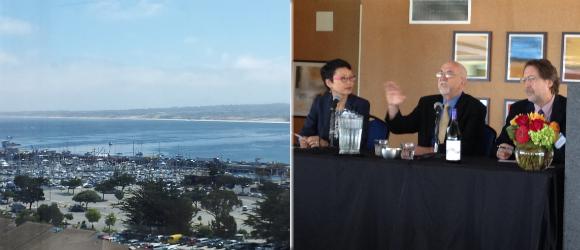
Monterey Bay and Van Ton-Quinlivan of California Community Colleges (left), Fred Silva of California Forward (middle), and Bruce Stenslie of Economic Development Cooperative, Ventura County. Photo Credit: Susan Lovenburg, Bonnie Mace)
When asked what they would fix with a magic wand, some attendees of a Monterey Bay area economic forum this week said they’d want to showcase the positive story of Monterey and California as places for innovation and investment.
Clearly there’s no magic wand for economic development–although there is some magical scenery near the Peninsula–but one way is getting everyone in a region in on the conversation about how to improve the workforce, infrastructure and business climate.
That was a goal of the second annual Monterey Bay Critical Conversation, part of the California Economic Summit’s regional discussions, and hosted by the Monterey County Business Council. Participants were also on the lookout for creative thinking on the part of government officials when working with business.
“It’s about having a more practical implementation and thinking outside of the box, and using entrepreneurial means to meet those common goals,” said Kristina Chavez Wyatt, president and owner Farmhouse Communications, LLC and executive director of the San Benito County Business Council. “We’ve all been working in silos for too long. It’s a huge detriment to us on the local and state level, especially on the Central Coast. We need more engagement.”
A range of issues bubbled up during presentations and when attendees broke into workgroups, the area’s infrastructure being a big one. Completing road upgrades, water storage and desalination projects, and increasing broadband access are major needs for the region.
The road work includes enhancement projects on nearby Highway 101 (to make it an official “transit corridor”) and the widening of Highway 156, which bridges the 101 to Highway 1. Advocates view these projects as key to the goods movement and workforce of the region’s big employers.
“A lot of it is getting agricultural commodities to market and getting folks to work and tourists to travel throughout our region,” said Wyatt.
Solving the local infrastructure puzzle is not just about getting through local opposition and review processes, it’s about how projects get funded. These projects, though, have become cost prohibitive because of a range of issues, said Wyatt. But creating toll roads to fund projects carries a difficulty for the working populations who have hospitality or construction labor jobs.
The inability to find ways to fund infrastructure will put drag on the regional economies of California and it’s been a major goal of the California Economic Summit’s Infrastructure Action Team to help region’s find more funding tools.
“The state simply isn’t going to put the level of resources into infrastructure that it used to for a variety of reasons,” said Fred Silva, senior fiscal policy advisor at California Forward. “This particular administration and future administrations are going to be concerned about the amount of indebtedness that the state has with respect to that investment.”
Silva was quizzed by attendees on the impact of two new, important developments: the expansion of infrastructure financing districts and the deal securing cap-and-trade funding for housing and infrastructure.
Bud Colligan, a venture capitalist and founder of Central Coast Angels, told the group the Monterey area needs to leverage the region’s technical people to create business growth.
In that vein, business leaders were touting a new one-stop website for the region, designed to keep businesses in the area and attract new ones and set to officially launch on July 7 (mbep.biz).
Businesses would be able to view city profiles, permitting information, success stories, telecom and property data, plus the positive story of the area’s assets that the Monterey County Business Council and others are trying to get out there.
“A group of us came together over the last couple of years and realized that we needed to have a website that display all of the assets in the region not one of our entities has it all, but if we put it all together as a tri-county region we can attract any type of business, we can keep the businesses we have and we can grow jobs,” said Mary Ann Leffel, president of the Monterey County Business Council.
Obviously, telling a story and following through with some smart, sustainable economic development are different things, but it’s important for these types of collaborative and critical conversations to take place.
We’re telling a different story than Charleston, South Carolina,” said Guillermo Mazer of Atlas Advertising, which built the new website. “We’re telling a different story than Tampa, Florida. We’re making pretty bold claims both using the assets that we have and the success stories are here. We appreciate natural beauty and the companies that appreciate healthy living. We’re telling stories of the companies that have made this region great over time. It could be in ag. It could be in tech whatever the case may be. But we’re starting to build that foundation.”

